阅读理解2
2023高考英语全国乙卷C篇阅读理解翻译及解析 (2)
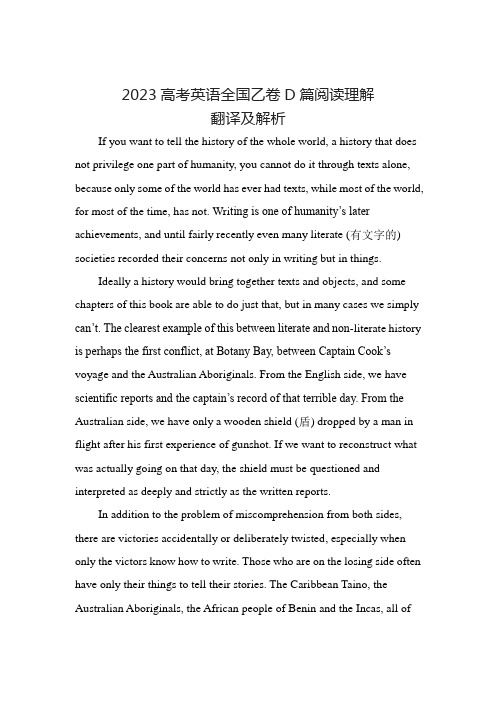
2023高考英语全国乙卷D篇阅读理解翻译及解析If you want to tell the history of the whole world, a history that does not privilege one part of humanity, you cannot do it through texts alone, because only some of the world has ever had texts, while most of the world, for most of the time, has not. Wri ting is one of humanity’s later achievements, and until fairly recently even many literate (有文字的) societies recorded their concerns not only in writing but in things.Ideally a history would bring together texts and objects, and some chapters of this book are able to do just that, but in many cases we simply can’t. The clearest example of this between literate and non-literate history is perhaps the first conflict, at Botany Bay, between Captain Cook’s voyage and the Australian Aboriginals. From the English side, we have scientific reports and the captain’s record of that terrible day. From the Australian side, we have only a wooden shield (盾) dropped by a man in flight after his first experience of gunshot. If we want to reconstruct what was actually going on that day, the shield must be questioned and interpreted as deeply and strictly as the written reports.In addition to the problem of miscomprehension from both sides, there are victories accidentally or deliberately twisted, especially when only the victors know how to write. Those who are on the losing side often have only their things to tell their stories. The Caribbean Taino, the Australian Aboriginals, the African people of Benin and the Incas, all ofwhom appear in this book, can speak to us now of their past achievements most powerfully through the objects they made: a history told through things gives them back a voice. When we consider contact (联系) between literate and non-literate societies such as these, all our first-hand accounts are necessarily twisted, only one half of a dialogue. If we are to find the other half of that conversation, we have to read not just the texts, but the objects.12. What is the first paragraph mainly about?A. How past events should be presented.B. What humanity is concerned about.C. Whether facts speak louder than words.D. Why written language is reliable.13. What does the author indicate by mentioning Captain Cook in paragraph 2?A. His report was scientific.B. He represented the local people.C. He ruled over Botany Bay.D. His record was one-sided.14. What does the underlined word “conversation” in paragraph 3 refer to?A. Problem.B. History.C. V oice.D. Society.15. Which of the following books is the text most likely selected from?A. How Maps Tell Stories of the WorldB. A Short History of AustraliaC. A History of the World in 100 ObjectsD. How Art Works Tell Stories如果你想讲述整个世界的历史,一段不赋予人类一部分特权的历史,你不能只通过文本来讲述,因为世界上只有一些地区有文本,而世界上大多数地区在大多数时候都没有。
人教部编版四年级语文上册--阅读理解专题训练2-同步练习题(含答案)

部编版四年级语文上册--阅读理解专题训练2一、快妈妈我的妈妈有个特点,就是不管干什么事都很快。
我管妈妈叫“快妈妈”。
妈妈不是会织毛衣吗?她不知道一年中给大伙织过多少毛衣毛裤。
一次,我家的邻居给别人加工毛衣的前身,结果期限快到了,还剩下十多件毛衣前身没织出来,正在发愁,这事恰巧被妈妈知道了,她便去拿了五件。
回到家里,我对妈妈说:“你拿这么多毛线回来干啥呀?”妈妈微微一笑说:“这几天邻居张阿姨家活紧,我闲着也没事,帮她织毛衣。
”我极不情愿地小声嘟哝:“家里的活就够你忙的了,自找麻烦。
”“看你说的,咱有难处时,邻居们不是都很照顾吗?人帮人图个啥?还不是图个心里踏实吗?你前些天不是还给我讲你们老师告诉你,能给别人做事本身就是一种幸福吗?怎么这么快就忘了?”我不好意思了。
晚饭后,妈妈就不停地织起来。
当我一觉醒来时,妈妈还在“飞针走线”,朦胧中,我看见妈妈的手在飞快地抖动,却辨不出何时“飞针”,何时“走线”,只见线团在变“瘦”,毛衣在“长”长。
不过一天一夜的工夫,妈妈就织了三件,五件活两天的时间就织完了。
你说这不是“快妈妈”吗?妈妈不但织毛衣快,干家务活更快。
一天晚上,邻居张阿姨家里有客,包饺子忙不过来,便叫妈妈帮忙。
这回她算请对人了。
妈妈去了不到一个钟头,饺子就包完了,乐得张阿姨眉开眼笑。
你说,我妈妈够得上是“快妈妈”吧!1.本文是按_____________________的结构方式来写的。
2.用“”画出文中的过渡句。
3.本文记叙了“快妈妈”的两件事。
第一件:_________________________________________________第二件:________________________________________________其中第( )件事是作者重点记叙的。
4.文中的“妈妈”有什么特点?从这的两件事中,可以看出“妈妈”这个人物具有怎样的思想品质?(1)妈妈的特点:_____________________________________________(2)妈妈的思想品质:_________________________________________5.“快妈妈”让我想到了奔跑很快的________(填动物名称)。
第二部分(大学英语统考)阅读理解(2)全真翻译版
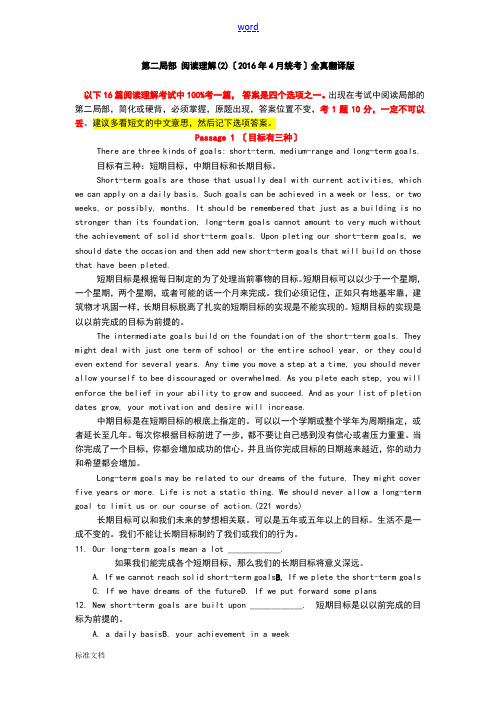
第二局部阅读理解(2)〔2016年4月统考〕全真翻译版以下16篇阅读理解考试中100%考一篇,答案是四个选项之一。
出现在考试中阅读局部的第二局部,简化或硬背,必须掌握,原题出现,答案位置不变,考1题10分,一定不可以丢。
建议多看短文的中文意思,然后记下选项答案。
Passage 1 〔目标有三种〕There are three kinds of goals: short-term, medium-range and long-term goals.目标有三种:短期目标,中期目标和长期目标。
Short-term goals are those that usually deal with current activities, which we can apply on a daily basis. Such goals can be achieved in a week or less, or two weeks, or possibly, months. It should be remembered that just as a building is no stronger than its foundation, long-term goals cannot amount to very much without the achievement of solid short-term goals. Upon pleting our short-term goals, we should date the occasion and then add new short-term goals that will build on those that have been pleted.短期目标是根据每日制定的为了处理当前事物的目标。
短期目标可以以少于一个星期,一个星期,两个星期,或者可能的话一个月来完成。
七年级英语期中复习专题练习《阅读理解2》
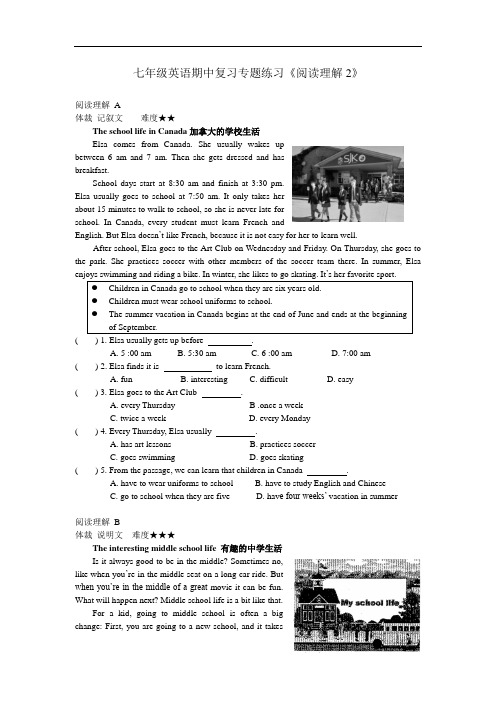
七年级英语期中复习专题练习《阅读理解2》阅读理解A体裁记叙文难度★★The school life in Canada加拿大的学校生活Elsa comes from Canada. She usually wakes upbetween 6 am and 7 am. Then she gets dressed and hasbreakfast.School days start at 8:30 am and finish at 3:30 pm.Elsa usually goes to school at 7:50 am. It only takes herabout 15 minutes to walk to school, so she is never late forschool. In Canada, every student must learn French andEnglish. But Elsa doesn’t like French, because it is not easy for her to learn well.After school, Elsa goes to the Art Club on Wednesday and Friday. On Thursday, she goes to the park. She practices soccer with other members of the soccer team there. In summer, Elsa●Children in Canada go to school when they are six years old.●Children must wear school uniforms to school.●The summer vacation in Canada begins at the end of June and ends at the beginningof September.( ) 1. Elsa usually gets up before .A. 5 :00 amB. 5:30 amC. 6 :00 amD. 7:00 am( ) 2. Elsa finds it is to learn French.A. funB. interestingC. difficultD. easy( ) 3. Elsa goes to the Art Club .A. every Thursday B .once a weekC. twice a weekD. every Monday( ) 4. Every Thursday, Elsa usually .A. has art lessonsB. practices soccerC. goes swimmingD. goes skating( ) 5. From the passage, we can learn that children in Canada .A. have to wear uniforms to schoolB. have to study English and ChineseC. go to school when they are fiveD. hav e four weeks’ vacation in summer阅读理解B体裁说明文难度★★★The interesting middle school life 有趣的中学生活Is it always good to be in the middle? Sometimes no,like when you’re in the middle seat on a long car ride. Butwhen you’re in the middle of a great movie it can be fun.What will happen next? Middle school life is a bit like that.For a kid, going to middle school is often a bigchange: First, you are going to a new school, and it takestime to get used to it. Second, you may have to make new friends. Third, you will have more teachers and study more subjects. All this can scare(使害怕)you on the first day of school. Here are some tips that will help you. Prepare for day1,eat breakfast on the big day and try to be brave, and trust yourself that you can do a good job.Prepare for day 1.Think about what you’ll wear. Choose something that you like and feel comfortable in. If you have a school uniform, try it on to see if it fits. Go to bed on time the night before. Try to get a good night’s sleep, even if you’re very excited. Before going to bed, lay out(摆出)all your stuff. That way, you won’t forget anything.On the big day, eat breakfast.You need your energy on the big day, so eat a big breakfast.Try to be brave.Say “Hi” to your new classmates. In class, listen to what the teacher says and take notes. You can look over (翻阅) them when you get home and prepare for day 2.Trust yourself.After a week, you might find life in middle school is fun. You will have new friends and learn more things. What’s more, you will be growing up. Trust yourself : You can do well in middle school.( ) 1. According to the passage, kids may feel a little when they start middle school.A. freeB. braveC. afraidD. excited( ) 2. The underlined word “stuff” is similar in meaning to “________”.A. textbooksB. thingsC. pensD. schoolbags( ) 3. You should say “Hi” to your new classmates to show that you are .A. honestB. hard-workingC. friendlyD. happy( ) 4. The author writes this passage mainly to .A. kids’ parentsB. kids’ teachersC. kids to begin middle schoolD. students to move to a new school阅读理解C体裁新闻报道难度★★★The Very Hungry Caterpillar turns 50《好饿的毛毛虫》出版50周年Eric Carle is the writer. Then he was a small child, his father oftentook him out into nature. Those were happy times for him. “He wouldshow me worms(蠕虫), bees and ants, and explain (解释)their lives tome,” said Carle .In the story, a caterpillar eats a lot of food through the week. In theend, he becomes a beautiful butterfly.Children can see themselves in the small caterpillar. He grows up. Heunfolds(展开)his wings and flies into the world. So do children!It’s only 224 words long. But the story has sold over 50 million copies. It is The Very Hungry Caterpillar. The book turns 50 this year!There is now an exhibition at a German museum. It’s called“Eric Carle’s Picture Books:50 Years of The Very Hungry Caterpillar”. Do you have free times Check it out!( ) 1. When Eric Carle was young, his father .A. played with him inside the houseB .took him out into natureC. ate a lot of food through weeksD. showed him small plants( ) 2. What does the underlined word “nature" in Paragraph 1 mean in Chinese?A.自然.B.课堂.C.节目D.幻想.( ) 3. Why can children see themselves in the caterpillar?A. Because they have wings.B. Because they want to fly.C .Because they grow like it D. Because they like nature.( ) 4. According to the passage, we know that The Very Hungry Caterpillar.A. is a picture bookB. has many pagesC. has sold 50 copiesD. is a cartoon book( ) 5. The passage mainly tells us about .A. a caterpillar’s lifeB. the writer’s happy childhoodC. a short picture bookD. an exhibition at a museum阅读理解 D体裁说明文难度★★★How to keep safe in school?在学校如何保持安全?The last Monday in March is an important day in China. It is a day for school safety education. At school, the big accidents are mainly stampedes(踩踏), earthquakes and fires.A stampede always happens in crowded places.When students around yon begin to push, stand thereand try to hold onto something. If you fall down in thecrowd, put your hands around your head. Move to oneside, and bend(弯曲)your body and legs.Earthquakes happen all over the world. When you feel everything is moving, quickly get under a desk and hold on. If you are outdoors, find a place away from buildings, trees, and power lines(电线). In Japan, many school take earthquake drills once a month. They help students stay calm in a real earthquake.When there’s a fire, leave the classroom quickly. It’s better to put something wet over your mouth and nose. This way,you won’t breathe in smoke. When there’s a fire, people can’t jump out of the window from higher than two stories(楼层). They may hurt themselves. In the US, most school buildings have fire escapes(防火梯). They are usually made of steel and lie outside the building. People can get to the fire escape through a special door or a window.( ) 1. What are the main accidents at school?①stampedes ②earthquakes ③fires ④fightsA.①②③B.②③④C.①③④D.①②④( ) 2. Which of the following is RIGHT when an earthquake happens?A. Stay under a tree if you are outside.B. Quickly get under a desk if you are in the classroom.C. Stand there and hold onto something if you are in a room.D. Jump out of the window from buildings.( ) 3. What does the underlined word “calm” in Paragraph 3 mean in Chinese?A.健康的.B.醒着的.C.镇定的.D.乐观的.( ) 4. What is the passage mainly about?A. Keeping safe in school.B. What to do if you are in crowded places.C. School safety in China is not a problem.D. What accidents happen most in different countries.阅读理解A体裁记叙文难度★★Saving the earth by saving money存钱拯救地球Jose Condori is a Peruvian(秘鲁的)boy. When he wasjust seven years old, he started the Bartselana Student Bank.The bank is very unusual. It not only helps students savemoney, but also helps them save the earth.He thought of the idea after seeing his classmatesspend all their pocket money on toys. And many old toyswere thrown away every year. Condori thought this was abig waste. After talking with his teachers about it, he knew something could be done. So he started his bank.Here is how the bank works: Students bring in plastic waste. The waste is sold to a recycling company. The company turns some of the waste into new products. Condori’s bank makes money from this process(过程). Part of the money is put into the students’bank accounts(账户). The students can take the money out when they reach their savings goal(目标).At first, the bank had only 20 members. Now, there are 2, 000 members. That number is still rising. Condori is bring his bank to more cities. He wants to help more people save money while saving the environment. Will you become a member of the bank when it comes to your city one day?( ) l. Which of the following is NOT true about Jose Condori according to the passage?A. He is from Peru.B. He started the Bartselana Student Bank at the age of 7.C. He thought his classmates shouldn’t spend all their pocket m oney on toys.D. He did not help students save money to save the earth.( ) 2. Why did Jose Condori want to start the bank?A. Because he thought it was a waste to spend all pocket money on toys.B. Because his teachers asked him to do so.C. Because the bank turned waste into new products.D. Because he thought his bank could make money for him.( ) 3. Which is the right order of how the bank makes money?①The recycling company recycles the waste.②The bank gets money from their process.③Students bring in plastic waste.④The waste is turned into new products.A. ③④②①B.①③④②C.③①④②D.①④③②( ) 4. Who can get the money the bank makes?A. The recycling company.B. The students.C. Condori’s teachers.D. The students’ parents.( ) 5. What can we infer according to the passage?A. The Bartselana Student Bank isn’t different from other banks.B. Condori likes throwing away old toys.C. The Bartselana Student Bank is becoming more and more popular.D. Condori helps people save money to save the environment.阅读理解B体栽说明文难度★★★The bike license 自行车驾照In Germany(德国), most children learn how to ridetheir bikes when they are quite young. But if they want toride bikes by themselves on the road, they have to pass atest. The test is quite like our driving test.First, the students must learn about how to ride bikessafely on the road. They’ll have about 30 classes. Eachstudent has a book and the book tells them how to keepsafe on the road, how to keep others safe and what to do if they get hurt. Look at the picture. Here is a page from the book. It tells the students the right way to turn left.After the classes, the students will have two written tests(笔试). Then, they will do some riding practice at school. Some policemen will come to give them more guides.At last, the students will have a test on the road. Some policemen will grade the students. If they can pass the test, they can get a bike license. Then they are ready for the road!We all know German people are very precise. We can see this from their riding test for the primary school students. The students learn useful riding skills, and at the same time, they learn the spirit(精神) of the country!( ) 1. From the picture we can know the students want to .A. turn rightB. turn leftC. say hello to friendsD. pass a driving test( ) 2. What should German students do first if they want to ride bikes on the road?A. Have two written tests.B. Have a riding test on the road.C. Do some riding practice at school.D. Learn about how to ride bikes safely on the road.( ) 3. The underlined word “precise” in the last paragraph is similar in meaning to“”.A. carefulB. helpfulC. luckyD. special( ) 4. What does the passage mainly talk about?A. A bike license is very useful.B .Why a student should get a bike license.C. How German students get a bike license.D. The riding skills of German students are very good.阅读理解C体裁新闻报道难度★★★A competition for fat bears in Alaska阿拉斯加胖熊争霸赛Fall(秋天)is here again. And it’s that time of year when it gets a little colder, the days get a little shorter, and the bears get much, much fatter.Every year at this time, there is a competition for bears in Alaska’s Katmai National Park to look for the fattest bear in the park. Online voters(网上投票者) around the world will choose the winner. Thecompetition goes on for a week, so it is called Fat BearWeek. This year’s competition ended on October 8.Thewinner was a bear named Holly. Between July 12 andSeptember 22, she grew from a thin bear into a giantbeast(巨兽).Bears have to get fat so that they can hibernate(冬眠). By the time they go into hibernation, male brown bears weigh from 600 pounds(272 kg)to 900 pounds(408 kg). Adult females usually weigh about a third less. Hibernation can last for half a year and a bear can lose up to one third of its weight during this time. So it’s healthy for the bears to get fat. If the hears don’t get fat enough, they could die during hibernation.( ) 1. can choose which bear is the fattest and wins the competition.A. Workers in the parkB. People around the worldC. Scientists in AlaskaD. The bears themselves( ) 2. According to the passage, a 600-pound bear will weigh about after hibernation.A. 200 poundsB. 250 poundsC.300 poundsD. 400 pounds( ) 3. Paragraph 2 mainly tells us about .A. Fat Bear WeekB. Alaska’s Katmai National ParkC. the hibernation of bearsD. Holly, the fattest bear( ) 4. We can infer from the passage that the competition began on .A. September 22B. September 26C. October 2 D .October 8( ) 5. What can we learn about Holly from the passage?A. Holly won the competition on September 22.B. Holly will hibernate for about a year and may die during that time.C. Holly was a thin bear before July 12 and then became fat very fast.D. The aim of the competition was to get ready for hibernation.阅读理解D体裁新闻报道难度★★★The miniature model show微缩模型展Look at the picture carefully. Is the man wearing a pairof glasses a giant (巨人)? No, he isn’t. But why does helook so big? It’s only because he is in a miniature modelshow.The show fell on September 21 this year. So manypeople brought their own works to the show. Each work shows a tiny scene(场景). For example, one shows a corner of a road that is no more than 15 cm long. Another shows an office that is as small as an iPad. All of the people and animals in the scenes are as small as your fingertips(指尖). It’s like a “Lilliput”. What a lovely “Lilliput”!Kevin Bellman from Illogan, Cornwall, won the “Best in Show”. It took him two and a half months to make the scene.( ) 1. Who got the first place in the show?A. Kevin Bellman.B. Illogan,Cornwall.C. Lilliput.D. The West Cornwall.( ) 2. Which of the following is TRUE?A. The models at the show only show roads and offices.B. Kevin spent about sixty days making the scene.C. Kevin won the show because he made a lovely Lilliput.D. People looked really tall and big in front of the show.( ) 3. We can infer from the passage that .A. many people spent a lot of time on their worksB. it’s easy to make the models because they are so smallC. the show asked people to make the model on September 21D. people brought their works to the show to make themselves look big( ) 4. The underlined word“tiny" in Paragraph 2 means “”.A. bigB. specialC. interestingD. small( ) 5. What is the main idea of the passage?A. A giant took a trip to Lilliput.B. A giant showed his small office.C. A giant made a tiny scene.D. A miniature model show took place.参考答案(1)(2)(3)(4)(5)(6)(7)(8)阅读理解A1. D2. C3. C4. B5. A阅读理解B1. C2. B3. B4. B阅读理解C1. B2. A3. C4. A5. C 阅读理解D1. A2. B3. C4. A阅读理解A1. D2. A3. C4. B5. C 阅读理解B1. B2. D3. A4. C阅读理解C1. B2. D3. A4. C5. C 阅读理解D1. A2. D3. A4. D5. D。
2023年考研英语二真题答案之阅读理解Text 2部分
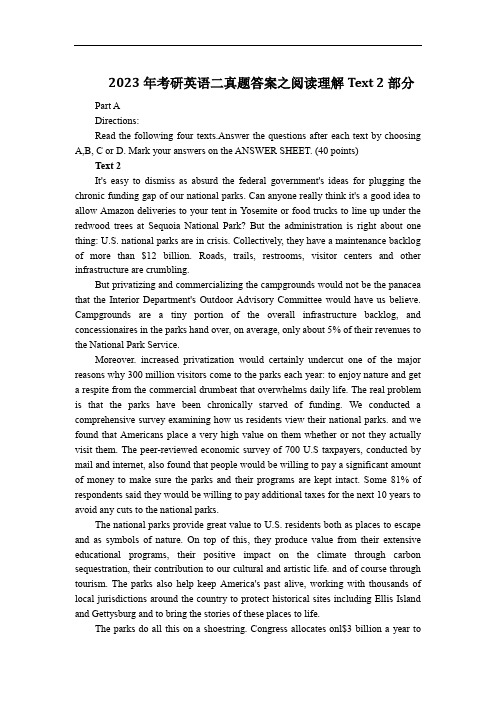
2023年考研英语二真题答案之阅读理解Text 2部分Part ADirections:Read the following four texts.Answer the questions after each text by choosing A,B, C or D. Mark your answers on the ANSWER SHEET. (40 points) Text 2It's easy to dismiss as absurd the federal government's ideas for plugging the chronic funding gap of our national parks. Can anyone really think it's a good idea to allow Amazon deliveries to your tent in Yosemite or food trucks to line up under the redwood trees at Sequoia National Park? But the administration is right about one thing: U.S. national parks are in crisis. Collectively, they have a maintenance backlog of more than $12 billion. Roads, trails, restrooms, visitor centers and other infrastructure are crumbling.But privatizing and commercializing the campgrounds would not be the panacea that the Interior Department's Outdoor Advisory Committee would have us believe. Campgrounds are a tiny portion of the overall infrastructure backlog, and concessionaires in the parks hand over, on average, only about 5% of their revenues to the National Park Service.Moreover. increased privatization would certainly undercut one of the major reasons why 300 million visitors come to the parks each year: to enjoy nature and get a respite from the commercial drumbeat that overwhelms daily life. The real problem is that the parks have been chronically starved of funding. We conducted a comprehensive survey examining how us residents view their national parks. and we found that Americans place a very high value on them whether or not they actually visit them. The peer-reviewed economic survey of 700 U.S taxpayers, conducted by mail and internet, also found that people would be willing to pay a significant amount of money to make sure the parks and their programs are kept intact. Some 81% of respondents said they would be willing to pay additional taxes for the next 10 years to avoid any cuts to the national parks.The national parks provide great value to U.S. residents both as places to escape and as symbols of nature. On top of this, they produce value from their extensive educational programs, their positive impact on the climate through carbon sequestration, their contribution to our cultural and artistic life. and of course through tourism. The parks also help keep America's past alive, working with thousands of local jurisdictions around the country to protect historical sites including Ellis Island and Gettysburg and to bring the stories of these places to life.The parks do all this on a shoestring. Congress allocates onl$3 billion a year tothe national park system an amount that has been flat since 2001 (in inflation-adjusted dollars) with the exception of a onetime boost in 2009 as part of the Obama stimulus package Meanwhile. the number of annual visitors has increased by more than 50% since 1980, and now stands at 330 million visitors per year.26. What problem are U.S. national parks faced with?A. decline of business profitsB. inadequate commercializationC. lack of transportation servicesD. poorly maintained infrastructure【答案】 D27. Increased privatization of the campground may?A. spoil visitor experienceB. help preserve natureC. bring operational pressureD. boost visits to parks【答案】 A28. according to para 5, most respondents in the survey would?A. go to the national parks on a regular basis.B. advocate a bigger budget for the national parksC. agree to pay extra for the national parksD. support the national parks' recent reforms【答案】 C29.The national parks are valuable in that they__.A. lead the way in tourismB. sponsor research on climateC. have historical significanceD. provide an income for the locals【答案】 C.30. It can be concluded from the text that the national park system_A. is able to cope with staff shortagesB. is able to meet visitor' demandsC. is in need of a new pricing policyD. is in need of a funding increase【答案】 D。
2022年考研英语一真题详解阅读理解text2
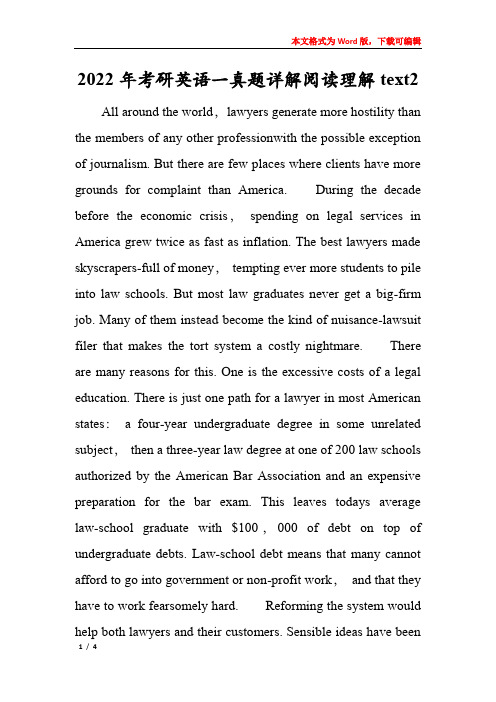
2022年考研英语一真题详解阅读理解text2 All around the world,lawyers generate more hostility than the members of any other professionwith the possible exception of journalism. But there are few places where clients have more grounds for complaint than America.During the decade before the economic crisis,spending on legal services in America grew twice as fast as inflation. The best lawyers made skyscrapers-full of money,tempting ever more students to pile into law schools. But most law graduates never get a big-firm job. Many of them instead become the kind of nuisance-lawsuit filer that makes the tort system a costly nightmare.There are many reasons for this. One is the excessive costs of a legal education. There is just one path for a lawyer in most American states:a four-year undergraduate degree in some unrelated subject,then a three-year law degree at one of 200 law schools authorized by the American Bar Association and an expensive preparation for the bar exam. This leaves todays average law-school graduate with $100,000 of debt on top of undergraduate debts. Law-school debt means that many cannot afford to go into government or non-profit work,and that they have to work fearsomely hard.Reforming the system would help both lawyers and their customers. Sensible ideas have beenaround for a long time,but the state-level bodies that govern the profession have been too conservative to implement them. One idea is to allow people to study law as an undergraduate degree. Another is to let students sit for the bar after only two years of law school. If the bar exam is truly a stern enough test for a would-be lawyer,those who can sit it earlier should be allowed to do so. Students who do not need the extra training could cut their debt mountain by a third.The other reason why costs are so high is the restrictive guild-like ownership structure of the business. Except in the District of Columbia,non-lawyers may not own any share of a law firm. This keeps fees high and innovation slow. There is pressure for change from within the profession,but opponents of change among the regulators insist that keeping outsiders out of a law firm isolates lawyers from the pressure to make money rather than serve clients ethically.In fact,allowing non-lawyers to own shares in law firms would reduce costs and improve services to customers,by encouraging law firms to use technology and to employ professional managers to focus on improving firms efficiency. After all,other countries,such as Australia and Britain,have started liberalizing their legal professions. America should follow.26. A lot of students take up law astheir profession due to______.[A]the growing demand from clients.[B]the increasing pressure of inflation.[C]the prospect of working in big firms.[D]the attraction of financial rewards.27. Which of the following adds to the costs of legal education in most American states?[A]Higher tuition fees for undergraduate studies.[B] Admissions approval from the bar association.[C] Pursuing a bachelors degree in another major.[D] Receiving training by professional associations.28. Hindrance to the reform of the legal system originates from________.[A]lawyers and clients strong resistance.[B]the rigid bodies governing the profession.[C]the stem exam for would-be lawyers.[D]non-professionals sharp criticism.29. The guild-like ownership structure is considered restrictive partly because it_______.[A]bans outsiders involvement in the profession.[B]keeps lawyers from holding law-firm shares.[C]aggravates the ethical situation in the trade.[D]prevents lawyers from gaining due profits.30. In this text,the author mainly discusses____________.[A]flawed ownership of Americas law firms and its causes.[B]the factors that help make a successful lawyer in America.[C]a problem in Americas legal profession and solutions to it.[D]the role of undergraduate studies in Americas legal education.【参考答案】26、D 27、C 28、B 29、A 30、C【主要内容】本文是是最近几年每年消失的法律学类文章,叙述美国法律界的一些问题及解决方法。
二年级阅读理解 (2)
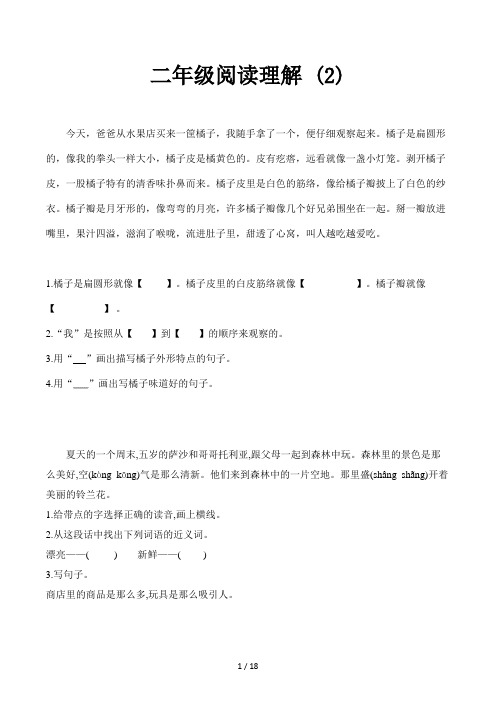
二年级阅读理解 (2)今天,爸爸从水果店买来一筐橘子,我随手拿了一个,便仔细观察起来。
橘子是扁圆形的,像我的拳头一样大小,橘子皮是橘黄色的。
皮有疙瘩,远看就像一盏小灯笼。
剥开橘子皮,一股橘子特有的清香味扑鼻而来。
橘子皮里是白色的筋络,像给橘子瓣披上了白色的纱衣。
橘子瓣是月牙形的,像弯弯的月亮,许多橘子瓣像几个好兄弟围坐在一起。
掰一瓣放进嘴里,果汁四溢,滋润了喉咙,流进肚子里,甜透了心窝,叫人越吃越爱吃。
1.橘子是扁圆形就像【】。
橘子皮里的白皮筋络就像【】。
橘子瓣就像【】。
2.“我”是按照从【】到【】的顺序来观察的。
3.用“”画出描写橘子外形特点的句子。
4.用“”画出写橘子味道好的句子。
夏天的一个周末,五岁的萨沙和哥哥托利亚,跟父母一起到森林中玩。
森林里的景色是那么美好,空(kòng kōng)气是那么清新。
他们来到森林中的一片空地。
那里盛(shâng shãng)开着美丽的铃兰花。
1.给带点的字选择正确的读音,画上横线。
2.从这段话中找出下列词语的近义词。
漂亮——( ) 新鲜——( )3.写句子。
商店里的商品是那么多,玩具是那么吸引人。
________________________________________________________________阅读《我要的是葫芦》片断,回答问题。
细长的葫芦藤上爬满了绿叶,开出了几朵雪白的小花。
花谢以后,藤上挂了几个小葫芦。
多么可爱的小葫芦啊!种葫芦的人每天都要去看几次。
1.这段话有_______句。
2.单选题。
【1】文中描写葫芦藤样子用的词语是【】A.可爱B.雪白C.细长【2】文中描写花儿颜色的词语是【】A.可爱B.雪白C.细长3.填入恰当的词语。
【 )的葫芦藤【 )的绿叶【 )的小花【 )的小葫芦4.第_______句写了葫芦藤和葫芦花的样子,第______句写了小葫芦的数量,第_____句写了那个人关心小葫芦。
英语阅读理解 (2)
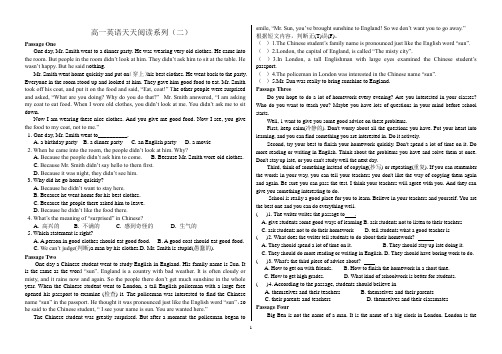
高一英语天天阅读系列(二)Passage OneOne day, Mr. Smith went to a dinner party. He was wearing very old clothes. He came into the room. But people in the room didn’t look at him. They didn’t ask him to sit at the table. He wasn’t happy. But he said n othing.Mr. Smith went home quickly and put on(穿上)his best clothes. He went back to the party. Everyone in the room stood up and looked at him. They gave him good food to eat. Mr. Smith took off his coat, and put it on the food and said, “Eat, coat!” T he other people were surprised and asked, “What are you doing? Why do you do that?”Mr. Smith answered, “I am asking my coat to eat food. When I wore old clothes, you didn’t look at me. You didn’t ask me to sit down.Now I am wearing these nice clothes. And you give me good food. Now I see, you give the food to my coat, not to me.”1. One day, Mr. Smith went to__________.A. a birthday partyB. a dinner partyC. an English partyD. a movie2. When he came into the room, the people didn’t look at him. Why?A. Because the people didn’t ask him to come.B. Because Mr. Smith wore old clothes.C. Because Mr. Smith didn’t say hello to them first.D. Because it was night, they didn’t see him.3. Why did he go home quickly?A. Because he didn’t want to stay here.B. Because he went home for his best clothes.C. Because the people there asked him to leave.D. Because he didn’t like the food there.4. What’s the meaning of “surprised” in Chinese?A. 高兴的B. 不满的C. 感到奇怪的D. 生气的5. Which statement is right?A. A person in good clothes should eat good food.B. A good coat should eat good food.C. We can’t judge(判断)a man by his clothes.D. Mr. Smith is stupid(愚蠢的).Passage TwoOne day a Chinese student went to study English in England. His family name is Sun. It is the same as the wor d “sun”. England is a country with bad weather. It is often cloudy or misty, and it rains now and again. So the people there don’t get much sunshine in the whole year. When the Chinese student went to London, a tall English policeman with a large face opened his passport to examine (检查) it. The policeman was interested to find the Chinese name “sun” in the passport. He thought it was pronounced just like the English word “sun”,so he said to the Chinese student, “ I see your name is sun. You are wanted here.”The Chinese student was greatly surprised. But after a moment the policeman began to smile, “Mr. Sun, you’ve brought sunshine to England! So we don’t want you to go away.”根据短文内容,判断正(T)误(F)。
- 1、下载文档前请自行甄别文档内容的完整性,平台不提供额外的编辑、内容补充、找答案等附加服务。
- 2、"仅部分预览"的文档,不可在线预览部分如存在完整性等问题,可反馈申请退款(可完整预览的文档不适用该条件!)。
- 3、如文档侵犯您的权益,请联系客服反馈,我们会尽快为您处理(人工客服工作时间:9:00-18:30)。
Whatever happened to the death of newspaper? A year ago the end seemed near. The recession threatened to remove the advertising and readers that had not already fled to the internet. Newspapers like the San Francisco Chronicle were chronicling their own do om. America’s Federal Trade commission launched a round of talks about how to save newspapers. Should they become charitable corporations? Should the state subsidize them ? It will hold another meeting soon. But the discussions now seem out of date.
In much of the world there is the sign of crisis. German and Brazilian papers have shrugged off the recession. Even American newspapers, which inhabit the most troubled come of the global industry, have not only survived but often returned to profit. Not the 20% profit margins that were routine a few years ago, but profit all the same.
It has not been much fun. Many papers stayed afloat by pushing journalists overboard. The American Society of News Editors reckons that 13,500 newsroom jobs have gone since 2007. Readers are paying more for slimmer products. Some papers even had the nerve to refuse delivery to distant suburbs. Yet these desperate measures have proved the right ones and, sadly for many journalists, they can be pushed further.
Newspapers are becoming more balanced businesses, with a healthier mix of revenues from readers and advertisers. American papers have long been highly unusual in their reliance on ads. Fully 87% of their revenues came from advertising in 2008, according to the Organization for Economic Cooperation & Development (OECD). In Japan the proportion is 35%. Not surprisingly, Japanese newspapers are much more stable.
The whirlwind that swept through newsrooms harmed everybody, but much of the damage has been concentrated in areas where newspaper are least distinctive. Car and film reviewers have gone. So have science and general business reporters. Foreign bureaus have been savagely cut off. Newspapers are less complete as a result. But completeness is no longer a virtue in the newspaper business.
26. By saying “Newspapers like … their own doom” (Lines 3-4, Para. 1), the author indicates that newspaper .
[A]neglected the sign of crisis
[B]failed to get state subsidies
[C]were not charitable corporations
[D]were in a desperate situation
27. Some newspapers refused delivery to distant suburbs probably because .
[A]readers threatened to pay less
[B]newspapers wanted to reduce costs
[C]journalists reported little about these areas
[D]subscribers complained about slimmer products
28. Compared with their American counterparts, Japanese newspapers are much more stable because they .
[A]have more sources of revenue
[B]have more balanced newsrooms
[C]are less dependent on advertising
[D]are less affected by readership
29. What can be inferred from the last paragraph about the current newspaper business?
[A]Distinctiveness is an essential feature of newspapers.
[B]Completeness is to blame for the failure of newspaper.
[C]Foreign bureaus play a crucial role in the newspaper business.
[D]Readers have lost their interest in car and film reviews.
30. The most appropriate title for this text would be .
[A]American Newspapers: Struggling for Survival
[B]American Newspapers: Gone with the Wind
[C]American Newspapers: A Thriving Business
[D]American Newspapers: A Hopeless Story。
